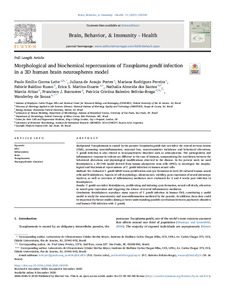Por favor, use este identificador para citar o enlazar este ítem:
https://repositorio.uca.edu.ar/handle/123456789/12526| Título: | Morphological and biochemical repercussions of Toxoplasma gondii infection in a 3D human brain neurospheres model | Autor: | Leite, Paulo Emilio Correa Araujo Portes, Juliana de Rodrigues Pereira, Mariana Baldino Russo, Fabiele Martins-Duarte, Erica S. Almeida, Nathalia dos Santos Attias, Marcia Barrantes, Francisco José Baleeiro Beltrão-Braga, Patricia Cristina Souza, Wanderley de |
Palabras clave: | TOXOPLASMA GONDII; TRASTORNOS NEUROPSIQUIATRICOS; INFLAMACION; CEREBRO | Fecha de publicación: | 2021 | Editorial: | Elsevier | Cita: | Leite, P. E. Correa et al. Morphological and biochemical repercussions of Toxoplasma gondii infection in a 3D human brain neurospheres model [en línea]. Brain, Behavior, & Immunity - Health. 2021, 11 (100190). doi: https://doi.org/10.1016/j.bbih.2020.100190. Disponible en: https://repositorio.uca.edu.ar/handle/123456789/12526 | Resumen: | Abstract: Background: Toxoplasmosis is caused by the parasite Toxoplasma gondii that can infect the central nervous system (CNS), promoting neuroinflammation, neuronal loss, neurotransmitter imbalance and behavioral alterations. T. gondii infection is also related to neuropsychiatric disorders such as schizophrenia. The pathogenicity and inflammatory response in rodents are different to the case of humans, compromising the correlation between the behavioral alterations and physiological modifications observed in the disease. In the present work we used BrainSpheres, a 3D CNS model derived from human pluripotent stem cells (iPSC), to investigate the morphological and biochemical repercussions of T. gondii infection in human neural cells. Methods: We evaluated T. gondii ME49 strain proliferation and cyst formation in both 2D cultured human neural cells and BrainSpheres. Aspects of cell morphology, ultrastructure, viability, gene expression of neural phenotype markers, as well as secretion of inflammatory mediators were evaluated for 2 and 4 weeks post infection in BrainSpheres. Results: T. gondii can infect BrainSpheres, proliferating and inducing cysts formation, neural cell death, alteration in neural gene expression and triggering the release of several inflammatory mediators. Conclusions: BrainSpheres reproduce many aspects of T. gondii infection in human CNS, constituting a useful model to study the neurotoxicity and neuroinflammation mediated by the parasite. In addition, these data could be important for future studies aiming at better understanding possible correlations between psychiatric disorders and human CNS infection with T. gondii. | URI: | https://repositorio.uca.edu.ar/handle/123456789/12526 | ISSN: | 2666-3546 (online) | Disciplina: | MEDICINA | DOI: | https://doi.org/10.1016/j.bbih.2020.100190 | Derechos: | Acceso abierto | Fuente: | Brain, Behavior, & Immunity - Health Vol.11, 100190, 2021 |
| Aparece en las colecciones: | Artículos |
Ficheros en este ítem:
| Fichero | Descripción | Tamaño | Formato | |
|---|---|---|---|---|
| morphological-biochemical-repercussions.pdf | 4,46 MB | Adobe PDF |  Visualizar/Abrir |
Visualizaciones de página(s)
82
comprobado en 27-abr-2024
Descarga(s)
177
comprobado en 27-abr-2024
Google ScholarTM
Ver en Google Scholar
Altmetric
Altmetric
Este ítem está sujeto a una Licencia Creative Commons

